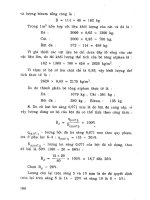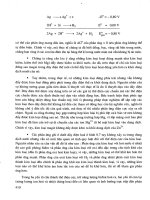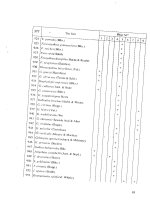Solar Cells Dye Sensitized Devices Part 9 potx
Bạn đang xem bản rút gọn của tài liệu. Xem và tải ngay bản đầy đủ của tài liệu tại đây (8.4 MB, 30 trang )
2.2.4.4 Tip to collector distance (TCD)
The distance of between capillary tip and collector can also influence fiber size by 1-2 orders
of magnitude. Additionally, this distance can dictate whether the end result is
electrospinning or electrospraying. Doshi and Reneker found that the fiber diameter
decreased with increasing distances from the Taylor cone [65].
2.2.4.5 Solvent volatility
Choice of solvent is also critical as to whether fibers are capable of forming, as well as
influencing fiber porosity. In order for sufficient solvent evaporation to occur between the
capillary tip and the collector a volatile solvent must be used. As the fiber jet travels through
the atmosphere toward the collector a phase separation occurs before the solid polymer
fibers are deposited, a process that is greatly influenced by volatility of the solvent. Zhao et
al. examined the structural properties of 15 wt % of poly(Vinylidene Fluoride) nanofibers
with different volume ratios in DMF/Acetone [66]. When DMF was used as the solvent
without acetone, bead-fibers were found. When 9:1 DMF/acetone was used a s the solvent
in the polymer solution, beads in the electrospun almost disappeared. Furthermore, the
ultafine fibers without beads demonstrated clearly when the acetone amount in the solution
increased to 20 %. Acetone is more volatile than DMF. Furthermore, the changes of solution
properties by the addition of acetone could probably improve the electrospun membrane
morphology and decrease the possibility of bead formation.
3. Results
3.1 Preparation of electrospun poly(vinylidene fluoride-hexafluoropropylene) (PVDF-
HFP) nanofibers
Generally, in the electrospinning method, the changing of the parameters had a great effect
on fiber morphology. To prepare the electrospun PVDF-HFP nanofiber films with the
suitable morphology, we prepared the electrospun PVDF-HFP nanofiber films by several
parameters such as the applied voltage(voltage supplier: NNC-ESP100, Nano NC Co., Ltd.),
the tip-to-collector distance (TCD), and the concentration of the PVDF-HFP. First, the PVDF-
HFP was dissolved in acetone/DMAc (7/3 weight ratio) for 24 hours at room temperature.
Then, we prepared the electrospun PVDF-HFP nanofibers by the electrospinning method
with different parameters. The applied voltage was ranged from 8 to 14 kV, TCD was varied
from 13 to 21 cm, and the concentration of PVDF-HFP varied from 11 to 17 wt %. On all
occasions, we used a syringe pump (781100, Kd Scientific) to control the flow rate of the
polymer solution, the solution flow rate was 2 ml/h.
In the electrospinning method, the changing of the polymer concentration had a great effect
on fiber morphology. To investigate the influence of polymer concentrations on the
electrospun PVDF-HFP nanofibers, we prepared the PVDF-HFP nanofibers. When the
polymer concentration were varied from 11 wt% to 17 wt%, TCD and applied voltages were
15 cm and 14 kV, respectively. Over the polymer solution of 19 wt% and below the polymer
solution of 9 wt%, the nanofibers did not form. Fig. 8 shows the surface images of the
electrospun PVDF-HFP nanofibers observed by FE-SEM and the diameter distributions of
nanofibers. The increase of the polymer concentration resulted in an increase of the average
fiber diameter of the electrospun PVDF-HFP nanofibers. In particular, the PVDF-HFP
nanofiber, which was prepared from 15 wt% of polymer concentration showed a highly
regular morphology with an average diameter of 800 - 1000 nm.
Fig. 8. FE-SEM images of electrospun PVDF-HFP nanofibers with different polymer
concentrations (Applied voltage = 14 kV, TCD = 15 cm, flow rate = 2 ml/h) and their
diameter distributions: (a) 11 wt%, (b) 13 wt%, (c) 15 wt%, (d) 17 wt%.
Fig. 9. FE-SEM images of electrospun PVDF-HFP nanofiber with different applied voltages
(TCD = 15 cm, polymer concentration = 15 wt%, flow rate = 2 ml/h) and their diameter
distributions: (a) 8 kV, (b) 10 kV, (c) 12 kV, (d) 14 kV.
Fig. 10. FE-SEM images of electrospun PVDF-HFP nanofibers with different TCDs (Applied
voltage = 14 kV, polymer concentration = 15 wt%, flow rate = 2 ml/h) and their diameter
distributions: (a) 13 cm, (b) 15 cm, (c) 17 cm, (d) 19 cm.
To investigate the effect of applied voltage, experiments were carried out when the applied
voltage was varied from 8 kV to 14 kV, TCD and polymer concentrations were held at 15 cm
and 15 wt%, respectively. The morphologies of electrospun PVDF-HFP nanofibers prepared
are shown in Fig. 9.
In addition, we prepared the electrospun PVDF-HFP nanofibers when the TCD was varied
from 13 cm to 19 cm, applied voltage and polymer concentrations were held at 14 kV and 15
wt%, respectively. The morphologies of prepared electrospun PVDF-HFP nanofibers
prepared are shown in Fig. 10. When the TCD was just close below 13 cm, irregular fiber
morphology was formed, because the polymer jet arrived at the collector before the
solidification. Therefore, we were able to optimize the preparation condition at an applied
voltage of 14 kV, a polymer concentration of 15 wt%, and TCD of 15 cm to obtain the regular
PVDF-HFP nanofibers.
As the changing of such parameters in the electrospinning method, the diameter and the
morphology of the nanofibers fabricated were changed. At the condition of the 15 wt% of
PVDF-HFP polymer solution, 14 kV of the applied voltage, 15 cm of the TCD and 2 ml/h of
the flow rate, the nanofibers of the electrospun PVDF-HFP films showed extremely regular
morphology with diameter of average 0.8 ~ 1.0 μm.
3.2 Characterizations of PVDF-HFP nanofibers
The pore size, the volume fraction and interconnectivity of pore domain, and the type of
porous polymer matrix will determine the uptake and the ion conductivity of the electrolyte
[63]. To investigate the effect of porous polymer matrix, the spin-coated PVDF-HFP film was
also fabricated by using conventional spin-coating method, and measured the ionic
conductivity under the same condition. The ionic conductivity of the spin-coated PVDF-HFP
film was 1.37×10
-3
S/cm, and this value showed lower value than the electrospun PVDF-
HFP nanofiber film.
To measure the uptake and the porosity of the electropsun PVDF-HFP nanofiber films from
electrolyte solution, the electropsun PVDF-HFP nanofiber films were taken out from the
electrolyte solution after activation and excess electrolyte solution on the film surface was
wiped.
The electrolyte uptake (U) was evaluated according to the following formula:
U= [(m-m
0
)/m
0
]×100%
where m and m
0
are the masses of wet and dry of the electrospun nanofiber films,
respectively.
The porosity (P) of the electrospun nanofibers was calculated from the density of
electrospun PVDF-HFP nanofibers (ρ
m
, g/cm
3
) and the density of pure PVDF-HFP (ρ
p
=
1.77g/cm
3
):
P (vol.%) = (1- ρ
m
/ρ
p
) ×100
The density of the electrospun PVDF-HFP nanofibers was determined by measuring the
volume and the weight of the electrospun PVDF-HFP nanofibers. The uptake and the
porosity of the electrospun PVDF-HFP nanofiber film was obtained 653±50 % and 70±2.3 %,
respectively, regardless the diameter and the morphology of nanofibers prepared with
various parameters.
3.3 Fabrications of DSSCs devices using PVDF-HFP nanofibers
We prepared the DSSC devices, sandwiched with working electrode using TiO
2
impregnated dyes and counter electrode using a platinum (Pt, T/SP) electrode as two
electrodes. The DSSC device was fabricated using this following process. The TiO
2
pastes
(Ti-Nanoxide, HT/SP) were spread on a FTO glass using the doctor blade method and
calcinated at 500
o
C. The sensitizer Cis-di(thiocyanato)-N,N-bis(2,2’-bypyridil-4.4’-
dicarboxylic acid)ruthenium (II) complex (N3 dye) was dissolved in pure ethanol in a
concentration of 20 mg per 100 ml of solution. The FTO glass deposited TiO
2
was dipped in
an ethanol solution at 45
o
C for 18 hours. The electospun PVDF-HFP nanofibers or the spin-
coated PVDF-HFP film were cut by 0.65 cm × 0.65 cm after drying, and put on the TiO
2
adsorbed the dyes, the electrolyte solution was dropped above them, and dried in a dry
oven at 45
o
C for 2 hours to evaporate wholly the solvent. To compare with the electrospun
PVDF-HFP nanofiber films, the conventional spin-coating method was used for making a
spin-coated PVDF-HFP film. In all cases, the thickness of the electrospun PVDF-HFP
nanofibers and spin-coated PVDF-HFP film were 30±1 μm by using digimatic micrometer.
The electrolyte was consisted of 0.10 M of iodine (I
2
), 0.30 M of 1-propyl-3-
methylimidazolium iodide (PMII), and 0.20 M of tetrabutylammonium iodide (TBAI) in the
solution of ethylene carbonate (EC)/ propylene carbonate (PC)/ acetonitrile (AN) (8:2:5
v/v/v). The Pt pastes were spread on a FTO glass using the doctor blade method and
calcinated at 400
o
C.
3.4 Photovoltaic properties of the DSSC devices using PVDF-HFP nanofibers
The DSSC devices using several different electrospun PVDF-HFP nanofibers on various
parameters were fabricated and their photovoltaic characteristics are summarized in Table 1
– 3. I-V curves of the DSSC devices using them are shown in Fig. 11. The concentration of
the PVDF-HFP solution was 15 wt% in acetone/DMAc (7/3 by weight ratio). The
photovoltaic characteristics of the DSSC devices were measured by using Solar Simulator
(150 W simulator, PEC-L11, PECCELL) under AM 1.5 and 100 mW/cm
2
of the light
intensity.
Fig. 11. I-V curves of DSSC devices using electrospun PVDF-HFP nanofibers under
illumination at AM 1.5 condition: (a) different polymer concentrations, (b) different applied
voltages, (c) different TCDs.
Polymer concentration
(wt.%)
V
OC
(V)
J
SC
(mA/cm
2
)
FF
η
(%)
11 0.74 10.88 0.60 4.78
13 0.73 10.57 0.62 4.78
15 0.74 10.89 0.63 5.02
17 0.72 9.92 0.62 4.41
Table 1. Photovoltaic performances of DSSC devices using electrospun PVDF-HFP
nanofibers on different polymer concentrations
Applied voltage
(kV)
V
OC
(V)
J
SC
(mA/cm
2
)
FF
η
(%)
8 0.74 10.50 0.57 4.41
10 0.73 10.10 0.56 4.17
12 0.74 10.30 0.58 4.35
14 0.74 10.88 0.63 5.02
Table 2. Photovoltaic performances of DSSC devices using electrospun PVDF-HFP
nanofibers on different applied voltages
TCD
(cm)
V
OC
(V)
J
SC
(mA/cm
2
)
FF
η
(%)
13 0.73 10.10 0.58 4.30
15 0.74 10.88 0.63 5.02
17 0.73 10.20 0.57 4.23
19 0.73 9.72 0.60 4.21
Table 3. Photovoltaic performances of DSSC devices using electrospun PVDF-HFP
nanofibers on different TCDs
Type V
OC
(V) J
SC
(mA/cm
2
) FF η (%)
Electrospun PVDF-HFP
nanofiber film
0.75 12.3 0.57 5.21
Spin-coated PVDF-HFP
film
0.67 3.87 0.55 1.43
Table 4. Photovoltaic characteristics of DSSC devices using electrospun PVDF-HFP
nanofiber film and spin-coated PVDF-HFP film in polymer electrolytes
The active area of the DSSC devices measured by using a black mask was 0.25 cm
2
. The V
OC
,
J
SC
, FF, and η of the DSSC device using the spin-coated PVDF-HFP film were 0.67 V, 3.87
mA/cm
2
, 0.56, and 1.43 %, respectively. The η of DSSC device using the spin-coated PVDF-
HFP film was lower than it of the DSSC device using electrospun PVDF-HFP nanofiber
films, because of the decrease of J
SC
, and all data are summarized in Table 4 and their I-V
curves are shown in Fig. 12. This result seemed that because the porosity of the electrospun
PVDF-HFP nanofibers is higher than it of the spin-coated PVDF-HFP film, ion transfer
occurred well and regular nanofiber morphology helped to transfer ion produced by redox
mechanism, therefore, overall power conversion efficiency of DSSC devices using the
electrospun PVDF-HFP nanofiber films was higher than that of the DSSC device using spin-
coated PVDF-HFP film. However, the minute change of nanofibers diameter was influenced
little on power conversion efficiency.
Voltage (V)
0.0 0.2 0.4 0.6 0.8
Current Density (mA/cm
2
)
0
2
4
6
8
10
12
14
Electrospun PVDF-HFP nanofibers
Spin-coated PVDF-HFP film
Fig. 12. I-V curves of the DSSC devices using electrospun PVDF-HFP nanofibers and spin-
coated PVDF-HFP film.
3.5 Effect of electrolyte in the electrospun PVDF-HFP nanofibers on DSSC
The photovoltaic performance of DSSC devices using the electrospun PVDF-HFP nanofibers
showed remarkable improved results compared to DSSC devices using the spin-coated
PVDF-HFP film. To prove these results, the interfacial charge transfer resistances were
investigated by the EIS measurement. The EIS data were measured with impedance
analyzer at same condition using FTO/TiO
2
/electrolyte/Pt/FTO cells, and fitted by Z-MAN
software (WONATECH) and Echem analyst (GAMRY). The Nyquist plots of the
FTO/TiO
2
/electrolyte/Pt/FTO cells and charge transfer resistances are shown in Fig. 13
and Table 5, respectively. The equivalent circuit of DSSC devices is shown in Fig. 14. The R
S
,
R1
CT
and R2
CT
were series resistance, the charge transfer resistance of Pt/electrolyte
interface, and the charge transfer resistance of TiO
2
/electrolyte interface, respectively. The
R2
CT
of the DSSC device using the spin-coated PVDF-HFP film was similar to that of the
DSSC device using the electrospun PVDF-HFP nanofibers. However, the R
S
and R1
CT
of the
DSSC device using the spin-coated PVDF-HFP film were higher than those of the DSSC
device using the electrospun PVDF-HFP nanofibers. These results showed that the spin-
coated film has a higher resistance than the electropun nanofibers, and poor I
-
/I
3-
activity
between Pt and electrolyte affected to the low value of the J
SC
. As a result, the η of the DSSC
device using the spin-coated PVDF-HFP film showed low value.
Type R
S
(Ω) R1
CT
(Ω) R2
CT
(Ω)
Electrospun PVDF-HFP
nanofibers
21.70 11.01 11.07
Spin-coated PVDF-HFP
film
31.87 25.02 14.37
Table 5. The series resistances (R
S
), the charge transfer resistance of the Pt/electrolyte (R1
CT
)
and TiO
2
/electrolyte (R2
CT
) in the DSSC devices under AM 1.5 by the EIS measurement
Fig. 13. Nyquist plots the FTO/TiO
2
/electrolyte/Pt/FTO device using (a) electrospun
PVDF-HFP nanofiber film electrolyte, and (b) spin-coated PVDF-HFP film electrolyte.
Fig. 14. The equivalent circuit of the DSSC device. (R
S:
Series resistance, R1
CT
: charge transfer
resistance of Pt/electrolyte, R2
CT:
charge transfer resistance of TiO
2
/electrolyte, Q1 and Q2:
constant phase element)
Fig. 15. Ionic conductivities of electrospun PVDF-HFP nanofiber films and J
sc
of DSSC
devices using electrospun PVDF-HFP nanofiber films with mole ratio of iodine to TBAI.
In addition, to investigate the photovoltaic effect of I
2
concentrations on DSSC using the
electrospun PVDF-HFP nanofiber, we prepared FTO/TiO
2
/Dye/Electrolyte/Pt/FTO
devices with various mole ratios of I
2
to TBAI in electrolyte solutions. In Table 6, as the
increase of the I
2
concentration in electrolyte, the ionic conductivity of the electrospun
PVDF-HFP nanofiber films increased, while the photocurrent density of the DSSC devices
using the electrospun PVDF-HFP nanofibers electrolyte decreased. The relationship between
the ionic conductivity the electrospun PVDF-HFP nanofiber films and the photocurrent
density of the DSSC devices are illustrated in Fig. 15 and I-V curves are shown in Fig. 16. In
general, the photocurrent density of DSSC using the liquid electrolyte is proportionate to the
ionic conductivity in electrolyte. From these results, we found that the photocurrent density
and the efficiency on DSSC using the electrospun PVDF-HFP nanofibers electrolyte are not
necessarily proportionate to the ionic conductivity in electrolyte.
Voltage (V)
0.0 0.2 0.4 0.6 0.8
Current Density (mA/cm
2
)
0
2
4
6
8
10
12
14
0.50
0.75
1.00
1.25
1.50
2.00
Fig. 16. The I-V curves of the DSSC devices using electrospun PVDF-HFP nanofibers with
mole ratio of iodine to TBAI.
4. Future outlooks
During the rebirth of polymer electrospining over the past decade the applicability of
electrospun fibers has become apparent across many fields. This highly adaptable process
allows the formation of functional fibrous membranes for applications such as tissue
engineering, drug delivery, sensor, cosmetic and photovoltaic devices. Electrospun
nanofibers offer an unprecedented flexibility and modularity in design. Improvements in
strength and durability, and their incorporation in composite membranes, will allow there
scaffolds to compete with existing membrane technology. Currently, the research field of
electrospnning is ripe with functional materials from resorbable cells to ceramic solid-phase
catalyst and continued research interest is expected to improve most areas of full cells and
photovoltaic cells.
5. Acknowledgement
This research was supported by the Converging Research Center Program through the
National Research Foundation of Korea (NRF) funded by the Ministry of Education, Science
and Technology (20090082141).
6. References
Adachi, M.; Murata, Y.; Okada, I. & Yoshikawa, S. (2003). Formation of Titania Nanotubes
and Applications for Dye-Sensitized Solar Cells. Journal of the Electrochemical Society,
Vol. 150, No. 8, pp. G488-G493, ISSN 0013-4651
Amadelli, R.; Argazzi, R.; Bignozzi, C. A. & Scandola, F. (1990). Design of antenna-sensitizer
polynuclear complexes. Sensitization of titanium dioxide with
[Ru(bpy)2(CN)2]2Ru(bpy(COO)2)22. Journal of the American Chemical Society, Vol.
112, No. 20, pp. 7099-7103, ISSN 0002-7863
Anton, Formhals (1934). Process and apparatus for preparing artificial threads. US Patent
1,975,504.
Anton, Formhals (1939). Method and apparatus for spinning. US Patent 2160962
Anton, Formhals (1940). Artificial thread and method of producing same. US Patent
2187306
Anton, Formhals (1944). Method and apparatus for spinning. US Patent 2349950
Armand, M. (1990). Polymers with Ionic Conductivity. Advanced Materials, Vol. 2, No. 6-7,
pp. 278-286, ISSN 1521-4095
Asano, T.; Kubo, T. & Nishikitani, Y. (2004). Electrochemical properties of dye-sensitized
solar cells fabricated with PVDF-type polymeric solid electrolytes. Journal of
Photochemistry and Photobiology A: Chemistry, Vol. 164, No. 1-3, pp. 111-115, ISSN
1010-6030
Bach, U.; Lupo, D.; Comte, P.; Moser, J. E.; Weissortel, F.; Salbeck, J.; Spreitzer, H. & Gratzel,
M. (1998). Solid-state dye-sensitized mesoporous TiO2 solar cells with high photon-
to-electron conversion efficiencies. Nature, Vol. 395, No. 6702, pp. 583-585, ISSN
0028-0836
Baumgarten, P. K. (1971). Electrostatic spinning of acrylic microfibers. Journal of Colloid and
Interface Science, Vol. 36, No. 1, pp. 71-79, ISSN 0021-9797
Berry, John P. (Wirral, GB2) (1990). Electrostatically produced structures and methods of
manufacturing. US Patent 4965110
Bornat, A. L., GB2) (1987). Production of electrostatically spun products. US Patent 4689186
Cao, J. H.; Zhu, B. K. & Xu, Y. Y. (2006). Structure and ionic conductivity of porous polymer
electrolytes based on PVDF-HFP copolymer membranes. Journal of Membrane
Science, Vol. 281, No. 1-2, pp. 446-453, ISSN 0376-7388
Caruso, R. A.; Schattka, J. H. & Greiner, A. (2001). Titanium Dioxide Tubes from Sol–Gel
Coating of Electrospun Polymer Fibers. Advanced Materials, Vol. 13, No. 20, pp.
1577-1579, ISSN 1521-4095.
Chand, S. (2000). Review Carbon fibers for composites. Journal of Materials Science, Vol. 35,
No. 6, pp. 1303-1313, ISSN 0022-2461
Deitzel, J. M.; Kleinmeyer, J.; Harris, D. & Tan, N. C. B. (2001). The effect of processing
variables on the morphology of electrospun nanofibers and textiles. Polymer, Vol.
42, No. 1, pp. 261-272, ISSN 0032-3861
Deitzel, J. M.; Kleinmeyer, J.; Harris, D. & Tan, N. C. B. (2001). The effect of processing
variables on the morphology of electrospun nanofibers and textiles. Polymer, Vol.
42, No. 1, pp. 261-272, ISSN 0032-3861.
Demir, M. M.; Yilgor, I.; Yilgor, E. & Erman, B. (2002). Electrospinning of polyurethane
fibers. Polymer, Vol. 43, No. 11, pp. 3303-3309, ISSN 0032-3861
Dloczik, L.; Ileperuma, O.; Lauermann, I.; Peter, L. M.; Ponomarev, E. A.; Redmond, G.;
Shaw, N. J. & Uhlendorf, I. (1997). Dynamic Response of Dye-Sensitized
Nanocrystalline Solar Cells: Characterization by Intensity-Modulated Photocurrent
Spectroscopy. The Journal of Physical Chemistry B, Vol. 101, No. 49, pp. 10281-10289,
ISSN 1520-6106
Doshi, J. & Reneker, D. H. (1995). Electrospinning process and applications of electrospun
fibers. Journal of Electrostatics, Vol. 35, No. 2-3, pp. 151-160, ISSN 0304-3886
Drozin, V. G. (1955). The electrical dispersion of liquids as aerosols. Journal of Colloid Science,
Vol. 10, No. 2, pp. 158-164, ISSN 0095-8522
Feng, L.; Li, S.; Li, H.; Zhai, J.; Song, Y.; Jiang, L. & Zhu, D. (2002). Super-Hydrophobic
Surface of Aligned Polyacrylonitrile Nanofibers. Angewandte Chemie International
Edition, Vol. 41, No. 7, pp. 1221-1223, ISSN 1521-3773
Grätzel, M. (2004). Conversion of sunlight to electric power by nanocrystalline dye-
sensitized solar cells. Journal of Photochemistry and Photobiology A: Chemistry, Vol.
164, No. 1-3, pp. 3-14, ISSN 1010-6030
Hagfeldt, A. & Gratzel, M. (1995). Light-Induced Redox Reactions in Nanocrystalline
Systems. Chemical Reviews, Vol. 95, No. 1, pp. 49-68, ISSN 0009-2665
Hagfeldt, A. & Grätzel, M. (2000). Molecular Photovoltaics. Accounts of Chemical Research,
Vol. 33, No. 5, pp. 269-277, ISSN 0001-4842
Hohman, M. M.; Shin, M.; Rutledge, G. & Brenner, M. P. (2001). Electrospinning and
electrically forced jets. II. Applications. Physics of Fluids, Vol. 13, No. 8, pp. 2221-
2236, ISSN 1070-6631
Hou, H. Q.; Jun, Z.; Reuning, A.; Schaper, A.; Wendorff, J. H. & Greiner, A. (2002). Poly(p-
xylylene) nanotubes by coating and removal of ultrathin polymer template fibers.
Macromolecules, Vol. 35, No. 7, pp. 2429-2431, ISSN 0024-9297
Hu Y. J.; Chen B.; Yuan Y. (2007). Preparation and Electrochemical Properties of Polymer Li-
ion Battery Reinforced by non-woven Fabric. J. Cent. South Univ.Technol, Vol. 14, No.
1, pp. 47-49, ISSN 1005-9784
Huang, H. T. & Wunder, S. L. (2001). Ionic conductivity of microporous PVDF-HFP/PS
polymer blends. Journal of the Electrochemical Society, Vol. 148, No. 3, pp. A279-A283,
ISSN 0013-4651
Huang, Z M.; Zhang, Y. Z.; Kotaki, M. & Ramakrishna, S. (2003). A review on polymer
nanofibers by electrospinning and their applications in nanocomposites. Composites
Science and Technology, Vol. 63, No. 15, pp. 2223-2253, ISSN 0266-3538
Huynh, W. U.; Dittmer, J. J. & Alivisatos, A. P. (2002). Hybrid Nanorod-Polymer Solar Cells.
Science, Vol. 295, No. 5564, pp. 2425-2427, ISSN 0036-8075
Jeong, Y B. & Kim, D W. (2004). Cycling performances of Li/LiCoO2 cell with polymer-
coated separator. Electrochimica Acta, Vol. 50, No. 2-3, pp. 323-326, ISSN 0013-4686
Kalyanasundaram, K. & Grätzel, M. (1998). Applications of functionalized transition metal
complexes in photonic and optoelectronic devices. Coordination Chemistry Reviews,
Vol. 177, No. 1, pp. 347-414, ISSN 0010-8545
Kelly, C. A. & Meyer, G. J. (2001). Excited state processes at sensitized nanocrystalline thin
film semiconductor interfaces. Coordination Chemistry Reviews, Vol. 211, No. 1, pp.
295-315, ISSN 0010-8545
Kim, D. W. & Sun, Y. K. (2001). Electrochemical characterization of gel polymer electrolytes
prepared with porous membranes. Journal of Power Sources, Vol. 102, No. 1-2, pp.
41-45, ISSN 0378-7753
Kim, D. W.; Kim, Y. R.; Park, J. K. & Moon, S. I. (1998). Electrical properties of the plasticized
polymer electrolytes based on acrylonitrile-methyl methacrylate copolymers. Solid
State Ionics, Vol. 106, No. 3-4, pp. 329-337, ISSN 0167-2738
Kim, J. R.; Choi, S. W.; Jo, S. M.; Lee, W. S. & Kim, B. C. (2005). Characterization and
properties of P(VdF-HFP)-based fibrous polymer electrolyte membrane prepared
by electrospinning. Journal of the Electrochemical Society, Vol. 152, No. 2, pp. A295-
A300, ISSN 0013-4651
Komiya, R.; Han, L.; Yamanaka, R.; Islam, A. & Mitate, T. (2004). Highly efficient quasi-solid
state dye-sensitized solar cell with ion conducting polymer electrolyte. Journal of
Photochemistry and Photobiology A: Chemistry, Vol. 164, No. 1-3, pp. 123-127, ISSN
1010-6030
Liu, H. & Hsieh, Y L. (2003). Surface methacrylation and graft copolymerization of ultrafine
cellulose fibers. Journal of Polymer Science Part B: Polymer Physics, Vol. 41, No. 9, pp.
953-964, ISSN 1099-0488
M. Armand, in: J.R. MacCallum, C.A. Vincent (Eds.). (1987). Current state of PEO-based
electrolyte Polymer Electrolyte Reviews-1, Elsevier Applied Science, London
Ma P. X.; Zhang R. (1999). Synthetic nano-scale fibrous extracellular matrix. pp. 60-72, John
Wiley
Martin, C. R. (1996). Membrane-Based Synthesis of Nanomaterials. Chemistry of Materials,
Vol. 8, No. 8, pp. 1739-1746, ISSN 0897-4756
McEvoy, A. J. & Grätzel, M. (1994). Sensitisation in photochemistry and photovoltaics. Solar
Energy Materials and Solar Cells, Vol. 32, No. 3, pp. 221-227, ISSN 0927-0248
Meyer, G. J. (1997). Efficient Light-to-Electrical Energy Conversion: Nanocrystalline TiO2
Films Modified with Inorganic Sensitizers. Journal of Chemical Education, Vol. 74,
No. 6, pp. 652l, ISSN 0021-9584
Michot, T.; Nishimoto, A. & Watanabe, M. (2000). Electrochemical properties of polymer gel
electrolytes based on poly(vinylidene fluoride) copolymer and homopolymer.
Electrochimica Acta, Vol. 45, No. 8-9, pp. 1347-1360, ISSN 0013-4686
Nazeeruddin, M. K.; Kay, A.; Rodicio, I.; Humphry-Baker, R.; Mueller, E.; Liska, P.;
Vlachopoulos, N. & Graetzel, M. (1993). Conversion of light to electricity by cis-
X2bis(2,2'-bipyridyl-4,4'-dicarboxylate)ruthenium(II) charge-transfer sensitizers
(X = Cl-, Br-, I-, CN-, and SCN-) on nanocrystalline titanium dioxide electrodes.
Journal of the American Chemical Society, Vol. 115, No. 14, pp. 6382-6390, ISSN 0002-
7863
Nelson, J. (1999). Continuous-time random-walk model of electron transport in
nanocrystalline TiO_{2} electrodes. Physical Review B, Vol. 59, No. 23, pp. 15374,
ISSN 1098-0121
Nogueira, A. F. & De Paoli, M A. (2000). A dye sensitized TiO2 photovoltaic cell
constructed with an elastomeric electrolyte. Solar Energy Materials and Solar Cells,
Vol. 61, No. 2, pp. 135-141, ISSN 0927-0248
Ondarçuhu, T. & Joachim, C. (1998). Drawing a single nanofibre over hundreds of microns.
EPL (Europhysics Letters), Vol. 42, No. 2, pp. 215, ISSN 0295-5075
O'Regan, B. and M. Gratzel (1991). A low-cost, high-efficiency solar cell based on dye-
sensitized colloidal TiO2 films. Nature, Vol.353, No.6346, pp. 737-740, ISSN 0028-
0836
Péchy, P.; Renouard, T.; Zakeeruddin, S. M.; Humphry-Baker, R.; Comte, P.; Liska, P.;
Cevey, L.; Costa, E.; Shklover, V.; Spiccia, L.; Deacon, G. B.; Bignozzi, C. A. &
Grätzel, M. (2001). Engineering of Efficient Panchromatic Sensitizers for
Nanocrystalline TiO2-Based Solar Cells. Journal of the American Chemical Society, Vol.
123, No. 8, pp. 1613-1624, ISSN 0002-7863
Reneker, D. H.; Kataphinan, W.; Theron, A.; Zussman, E. & Yarin, A. L. (2002). Nanofiber
garlands of polycaprolactone by electrospinning. Polymer, Vol. 43, No. 25, pp. 6785-
6794, ISSN 0032-3861
Senecal, Kris (N. Smithfield, RI, US); Samuelson, Lynne (Marlborough, MA, US); Sennett,
Michael (Sudbury, MA, US); Schreuder-gibson, Heidi (Holliston, MA, US) (2006).
Conductive (electrical, ionic, and photoelectric) polymer membrane articles, and
method for producing same. US Patent 7109136
Sill, T. J. & von Recum, H. A. (2008). Electrospinning: Applications in drug delivery and
tissue engineering. Biomaterials, Vol. 29, No. 13, pp. 1989-2006, ISSN 0142-9612
Smith, Daniel J. (Stow, OH); Reneker, Darrell H. (Akron, OH); Mcmanus, Albert T. (San
Antonio, TX); Schreuder-gibson, Heidi L. (Holliston, MA); Mello, Charlene
(Rochester, MA); Sennett, Michael S. (Sudbury, MA) (2004). Electrospun fibers and
an apparatus therefor. US Patent 6753454
Stephan, A. M.; Nahm, K. S.; Anbu Kulandainathan, M.; Ravi, G. & Wilson, J. (2006).
Poly(vinylidene fluoride-hexafluoropropylene) (PVdF-HFP) based composite
electrolytes for lithium batteries. European Polymer Journal, Vol. 42, No. 8, pp. 1728-
1734, ISSN 0014-3057
Stergiopoulos, T.; Arabatzis, I. M.; Katsaros, G. & Falaras, P. (2002). Binary Polyethylene
Oxide/Titania Solid-State Redox Electrolyte for Highly Efficient Nanocrystalline
TiO2 Photoelectrochemical Cells. Nano Letters, Vol. 2, No. 11, pp. 1259-1261, ISSN
1530-6984
Sze S M. (1981). Physics of Semiconductor Devices (New York : Wiley) p 264
Taylor, G. (1969). Electrically Driven Jets. Proceedings of the Royal Society of London. Series A,
Mathematical and Physical Sciences, Vol. 313, No. 1515, pp. 453-475, ISSN 0080-4630
van de Lagemaat, J.; Park, N. G. & Frank, A. J. (2000). Influence of Electrical Potential
Distribution, Charge Transport, and Recombination on the Photopotential and
Photocurrent Conversion Efficiency of Dye-Sensitized Nanocrystalline TiO2 Solar
Cells: A Study by Electrical Impedance and Optical Modulation Techniques. The
Journal of Physical Chemistry B, Vol. 104, No. 9, pp. 2044-2052, ISSN 1520-6106
Vonnegut, B. & Neubauer, R. L. (1952). Production of monodisperse liquid particles by
electrical atomization. Journal of Colloid Science, Vol. 7, No. 6, pp. 616-622, ISSN
0095-8522
Wang, P.; Zakeeruddin, S. M. & Grätzel, M. (2004). Solidifying liquid electrolytes with
fluorine polymer and silica nanoparticles for quasi-solid dye-sensitized solar cells.
Journal of Fluorine Chemistry, Vol. 125, No. 8, pp. 1241-1245, ISSN 0022-1139
Wang, P.; Zakeeruddin, S. M.; Moser, J. E.; Nazeeruddin, M. K.; Sekiguchi, T. & Gratzel, M.
(2003). A stable quasi-solid-state dye-sensitized solar cell with an amphiphilic
ruthenium sensitizer and polymer gel electrolyte. Nat Mater, Vol. 2, No. 6, pp. 402-
407, ISSN 1476-1122
Watanabe, M.; Kanba, M.; Matsuda, H.; Tsunemi, K.; Mizoguchi, K.; Tsuchida, E. &
Shinohara, I. (1981). High lithium ionic conductivity of polymeric solid electrolytes.
Die Makromolekulare Chemie, Rapid Communications, Vol. 2, No. 12, pp. 741-744, ISSN
0173-2803
Waters, Colin M. (Tattingstone, GB2); Noakes, Timothy J. (Selbourne, GB2); Pavey, Ian
(Fernhurst, GB2); Hitomi, Chiyoji (Tsokuba, JP) (1992). Liquid crystal devices. US
Patent 5088807
Zhizhen Zhao, Jingquing Li, Xiaoyan Yuan Xing Li, Yuanyuan Zhang, Jing Sheng. (2005).
journal of Applied Polmer Scence, 97, 466-474. Zhao, Z. Z.; Li, J. Q.; Yuan, X. Y.; Li, X.;
Zhang, Y. Y. & Sheng, J. (2005). Preparation and properties of electrospun
poly(vinylidene fluoride) membranes. Journal of Applied Polymer Science, Vol. 97,
No. 2, pp. 466-474, ISSN 0021-8995
11
Development of Dye-Sensitized Solar Cell for
High Conversion Efficiency
Yongwoo Kim
1
and Deugwoo Lee
2
1
Korea Industrial Complex Corporation
2
Pusan National University
Korea
1. Introduction
The Solar cell energy is presently promising because of oil inflation, fuel exhaustion, global
warming, and space development. Many advanced countries rapidly develop the solar cell
energy under a nation enterprise. Particularly, dye-sensitized solar cell (DSC), the 3rd
generation solar cell, has low-cost of manufactures about 1/3~1/5 times compared with the
silicon solar cell, which encourages the research globally.
Dye-sensitized Solar Cell (DSC) is evaluated to be low-cost technology as the manufacturing
DSC is more inexpensive 5 times than producing Silicon Solar Cell. Currently, the best
conversion efficiency is 11%, the tile-shaped modules are being produced in STI, Austria.
Moreover the efficiency to increase over 15% and the process of fabricating DSC for
commercialization are attempted to be highly researched.
Recently, production of nano-particles becomes available due to development of nano-
technologies. Since they have broad contact area comparing to the existing compound
materials being generally used and increased mechanical, thermal and electrical
characteristics, etc., they are attracting public attention as a new material to implement
various functions. Especially, nano-tube has more excellent mechanical and electrical
characteristics than normal particle type materials. And it is known that the smaller its
diameter, i.e. aspect ratio, is, the better its characteristics are. Accordingly a lot of researches
related to nano-compound materials have been being progressed nationally and
internationally (Gojny et al., 2003; Jijima, 1991; Chang et al., 2001).
It is new methods to improve light conversion efficiency using several approaches such as
nanocrystalline CNT/TiO
2
hybrid material, reflect mirror with micro pyramid structure,
and concentrating light with Fresnel lens.
Figure.1 shows the operational principle and structure of dye sensitized cell. If visible rays
are absorbed by n-type nano particles TiO
2
that dye molecules are chemically absorbed on
the surface, the dye molecules generate electron-hole pairs, and the electron were injected
into the conduction band of semiconductor’s oxides. These electrons that are injected into
the semiconductor’s oxide electrode generate current through each nano particles’
interfaces. The holes that are made from dye molecules are deoxidized by receiving
electrons, thus causing the dye-sensitized cells begin to work (Zhang et al., 2010).
Solar Cells – Dye-Sensitized Devices
246
Fig. 1. A schematic representation of the construction of a DSSC
Fig. 2. Process of manufacturing DSSC
We applied screen printing method on FTO membrane to TiO
2
paste in 20m. Coated
working electrode membrane was sintered at 450°C and digested them into dye (N719) for
about 12 hours.
Fig. 3. Measurement system and program
In order to understand efficiency increase of solar cells due to coating method, we compared
individual efficiencies using solar cell simulator. Measuring efficiency of solar cells had been
progressed under AM (air mass) 1.5 conditions (1sun, 100mW/cm
2
).
Development of Dye-Sensitized Solar Cell for High Conversion Efficiency
247
2. A study of photocatalyst of the TiO
2
thin film with acid dispersed CNT
As one of major variables of dye-sensitized solar cell, the dye absorbed light energy transits
from ground state to excited state and gets electron injection. Electrons are injected in a very
fast speed of femtosecond or picoseconds unit and oxidized dye is renewed within several
nanoseconds. On the other hand, since rejoining speed that the electron becomes dissolved
into electrolyte via surface state is slow such as micro seconds or milliseconds and most of
photons are injected semiconductor conduction band, those electrons that are not injected
meet holes again to be restored and decrease efficiency of solar cell. If we utilize CNT that is
advantageous for electrical and thermal conduction as a compound material, we can
increase electron injection speed than rejoining speed and increase efficiency of dye-
sensitized solar cells through movement of more electrons.
Since multi walled carbon nanotube (MWCNT) is a material to well transfer electricity and
heat, it can function as a basic electrode. Nanotubes function as electrodes to penetrate into
broad TiO
2
surface mutually and assist extracting charge carriers efficiently from dye layer.
Since these electrodes are very clear under longer wavelength, they are advantageous for
solar light spectrums.
This study utilizes CNT that is advantageous for electrical and thermal conduction as a
compound material so that surface resistance between clear electrodes and dye layer
decreases, electron injection speed can be increased more than the rejoining speed of
electrons and efficiency of dye-sensitized solar cell can be also increased through movement
of more electrons. In order to perform the task, this study will composite nano-crystal TiO
2
with sol-gel technique (Tracey et al., 1998), establish optimal thin film formation conditions
through identification of correlation between permeability and conductivity by
manufacturing distributed CNT through acid treatment and compound thin film, and
perform characteristics assessment by applying it to solar cells upon surface resistance
between dye layer and FTO.
Dye-sensitized solar cell is a device to apply photosynthesis principle of the plant by
combining pigments to absorb light energy within chloroplast with polymer and applying
them to the solar cell. Dye-sensitized solar cell basically consists of dye polymer to absorb
solar light, semiconductor compound having broad band gap serving as n-type
semiconductor, electrolyte serving as p-type semiconductor, relative electrode for catalysis,
and clear electrode to permeate solar light. Dye-sensitized solar cell is composed of
semiconductor nanoparticles where dye absorbs solar energy and separation/transfer of
generated electrons are diffused upon electron concentration difference. Processes to
generate and transfer electrons play an essential role to determine performance of the cells.
Firstly entering time of excited electrons from the dye into TiO
2
should be shorter than that
of joining with holes and being exterminated. Normally entering time of electron is very fast
in femtoseconds through picoseconds and oxidated dye is renewed within several
nanoseconds (Tachibana et al., 1996).
2.1 Composition of TiO
2
Manufacturing methods of TiO
2
for photocatalyst generally includes hydro thermal method
(Chen et al., 1995), sedimentation method (Ellis et al., 1989; Lee et al., 2000), sol-gel
technique (Ding et al., 1995; Johnson, 1985; Hwang & Kim, 1995), CVD method (Lee et al.,
1999), etc. Hydro thermal method that may get mainly powder materials has complex
equipment and difficult for continuous work, while sedimentation method allows easy
Solar Cells – Dye-Sensitized Devices
248
production but it has disadvantages cohesion between particles, powder with possibility of
uneven composition, and difficulties for fineness as bulk materials from sintering and
harmonization of crystalline. Comparing to them, sol-gel technique has advantages to allow
easy acquisition of TiO
2
powder for photocatalyst with even composition relatively simply
and low temperature composition available.
2.2 CNT dispersion
Carbon nanotube exists as a form of bundle or cohesion body due to strong van der Waals
forces between tubes as like interaction between graphite plates. This cohesion phenomenon
obstructs formation of 3-dimensional network structure in manufacturing compound to
increase electrical or mechanical properties. It is an important technology to disperse carbon
nanotube and release individual strand, as it increases functional efficiency. Dispersion
methods of carbon nanotube can be classified into mainly mechanical dispersion, dispersion
using strong acid, dispersion with solution, etc. Firstly, dispersion using strong acids is to
agitate with composition of nitric acid and hydrochloric acetone at 130°C for 6h or using
composition of sulfuric acid and hydrochloric acid. Dispersing with solution is to melt
carbon nanotubes through surface active agents such as SDS (sodium dodecyl sulfate),
Triton X-100, LDS, etc. The most various mechanical dispersion methods include supersonic
treatment by mixing acetone and methanole, or using ball milling method to minimize
length and diameter distribution of carbon nanotubes. Others include dispersions with
grinding process using mortars, abrasion process, high shear strength using liquid, etc.
2.3 Experiment method and conditions
2.3.1 Production and coating of CNT/TiO
2
TTIP that is used for this study generates photocatalyst TiO
2
under low temperature heating
conditions but it has a disadvantage fast hydrolysis with air or small moisture due to very
string reactivity. So we had made even chelate compound by adding AcAc into the ethanol
solution and severely agitating it for 30 minutes at room temperature using agitator in order
Fig. 4. Process of fabricating TiO
2
Thin Film
Development of Dye-Sensitized Solar Cell for High Conversion Efficiency
249
to control hydrolysis speed of TTIP. And we have prepared water solution by melting HCl
0.15 mole catalyst for stability of sol and PEG 0.5 mole adhesion to increase osculation with
plate to be coated into 50mole distilled water and drop it into the chelate compound. At the
moment, it is possible to manufacture yellow clear sol by severely agitating and reacting
chelate compound at room temperature for 90min.
For dispersion of CNT, we mixed 60% nitric acid and distilled water in 1:3 volume ratio and
severely agitated it at 130°C for 6h. After acid treatment, we mixed a lot of distilled water,
apply ultra sonication and continued to neutralize it using PTFE thin film filter with 1um in
diameter until it has been neutralized.
In order to understand permeability and electrical characteristics of composited TiO
2
sol and
dispersed CNT by concentrations, we have mage mixture solution by establishing variables
with Volume% concentrations 0.5, 2.5, 5 and 10.
This study with TiO
2
thin film manufacturing method using sol-gel technique has an
advantage to allow applying various processes such as dip-coating method, spinning
method, Spray, etc. As spray coating out of them has advantages such as uniform thickness,
various compositions to manufacture films by mixing solutions, no big influence from
viscosity of solution comparing to spinning method, and available coating without
influences from patterned plate, plate surface energy or roughness. It is considered that it is
the most appropriate for commercialization as it allows easy manufacture and application of
broad area plate.
2.3.2 Manufacture of Dye-sensitized solar cell
We applied composited CNT/TiO
2
to screen printing on FTO plate to coat about 3m in
thickness and coated TiO
2
paste from Dyesol in 15m. Then we could increase the whole
efficiency of cells by decreasing surface resistance between TiO
2
layer absorbed with dye
and FTO plate and assisting movement of electrons. Fig. 3 shows coated plated by CNT
concentrations, from which we can see that these plates with high content of CNT have
thicker colours. We sintered them at 450°C and digested them into dye (N719) for about 24
hours. We coated platinum onto FTO plate with relative electrode and sintered it at 450°C.
We sealed prepared 2 plates with Hot melt sheet having about 60m in thickness and
completed them by injecting electrolyte.
Fig. 5. Feature of CNT/TiO
2
thin film by screen-printing
Solar Cells – Dye-Sensitized Devices
250
2.4 Conclusion and considerations
2.4.1 Change of permeability upon CNT concentration
In order to check permeability and electrical characteristics of CNT by concentrations, We
coated glass plate with about 5m in thickness using spray technique, and produced TiO
2
thin film by increasing temperature and sintering it at 450°C for 1 hour. Fig. 6(a) shows
composited CNT/TiO
2
thin film surface with very small and even particle. In case of (b), it
shows thin film surface of TiO
2
paste from Dyesol with uneven large particles but very
excellent porosity. From the results of measurements for permeability of each thin film, as
CNT content increases, permeability drops straight and reaches only 10% when
concentration becomes 5, 10%.
Fig. 6. SEM images of CNT/TiO
2
(a) and TiO
2
paste(b)
Fig. 7.Transmissivity of TiO
2
layers
2.4.2 Change of surface resistance upon CNT concentration
Fig. 8 shows measurement results of surface resistances upon CNT concentrations. It shows
a graph acquired upon each condition by increasing voltage from -1V to 1V by 50mV
interval. As CNT concentration with excellent electrical characteristics increases and surface
resistance becomes low, it is considered that it would be advantageous for transfer of
electrons separated from the dye.
Development of Dye-Sensitized Solar Cell for High Conversion Efficiency
251
Fig. 8. I-V curve and resistance of TiO
2
layers
2.4.3 Efficiency change of Dye-sensitized solar cell upon CNT concentration
Fig. 9 shows I-V and P-V curve of CNT 0.5% indicating the highest energy efficiency out of
CNT concentrations. Efficiency can be calculated from output power by estimating voltage
(V
mp
) and current (I
mp
) to achieve the maximum output from I-V curve when strength of
solar light becomes input power.
Fig. 9. I-V and P-V curve of DSC with CNT 0.5%
Fig. 10. I
mp
and V
mp
of DSC of each CNT volume
Solar Cells – Dye-Sensitized Devices
252
In order to confirm if movement of electrons increases according to content of CNT within
CNT/TiO
2
compound material, we compared V
mp
and Imp values upon each condition on
Fig. 10. V
mp
values refer to voltage values when solar cell performs the maximum power,
and CNT contents show relatively even values throughout the whole areas. In case of Imp,
we can see that it shows high value on very low CNT content such as 0.5%. It means that a
lot of electrons are transferred comparing to no CNT, in spite of low generation of electrons
due to low permeability. Under high CNT content, such as 5, 10%, we can see that generated
electrons are small as surface resistance is low but permeability is low.
2.5 Conclusions
This study has confirmed efficiency of solar cells upon impact of permeability and surface
resistance by manufacturing CNT/TiO
2
compound material to increase transfer of electrons
separated from dye layer using sol-gel technique as a variable having effect on efficiency of
dye-sensitized solar cell and applying in to the solar cells.
It was possible to develop CNT/TiO
2
compound material to remarkably reduce surface
resistance of solar cells and increase efficiency of them and acquire the highest
efficiency at 0.5% Vol concentration of CNT.
It is concluded that as CNT concentration increases, surface resistance becomes low
with excellent electrical characteristics, but the solar cells reacting against solar light
receive large influence from permeability.
High permeability increases voltage of solar cells and CNT/TiO
2
compound material
with low surface resistance effectively transfers electrons generated from the dye, so
they contribute to increase of the current.
Fig. 11. Determine of optimum CNT volume of DSC
3. The recovery of light with a reflector of microstructures
We have studied a reflector recovering the loss light for improvement conversion efficiency
of DSC. One of methods to increase efficiency of dye-sensitized solar cell is to expand
surface area of semiconductor oxide such as TiO
2
. Since dye polymer has high efficiency
when it is absorbed on the semiconductor as a single molecule layer, solar light absorption
becomes larger as the surface area of the semiconductor on which dye polymer is absorbed
Development of Dye-Sensitized Solar Cell for High Conversion Efficiency
253
is wide. Consequently efficiency of the cell is improved as TiO
2
particles are small and
porousness is high. This study has researched that the dye produces electrons as much as
possible using a method to lengthen scattering distance by reflecting entered solar light
rather than expanding surface area of the oxide.
The reflector angle was determined by optical analysis program. Micro pyramid patterns
with the 112.6° were processed using the ultra precision shaping machine in order to
maximize the conversion efficiency due to increasing light distance. In addition, a
comparative study carried out about the conversion efficiency. We made the DSC that is
attached reflector with mirror angle 112.6° below. We measured conversion efficiency of
solar cell by solar simulator that can irradiate 100mW/cm
2
(1Sum, AM 1.5).
Fig. 12. Scheme of DSC with reflector
As a result of this experiment, the DSC with micro pyramid mirror improves efficiency
about 2% against the DSC with black plate. Reflected light can cross more dye of TiO
2
Layer.
Therefore, Voltage of maximum power (V
mp
) increases other reflector with different mirror
angle.
We propose a new method to improve light conversion efficiency using a reflector to collect
light being lost from permeation through the dye-sensitized solar cell. The goals of this
study are to
Fabrication of reflector with microstructure
Improve working distance of scattering light
Control mirror angle by optimum design
Improve photoelectric efficiency with micro pyramid arrayed mirror
3.1 Light simulation
We designed a micro reflector to lengthen scattering distance of reflected solar light on the
dye layer of dye-sensitized solar cell using light analysis program.
In order to maximize light scattering distance of dye layer, we allowed value of Light Angle
(θ
l
) to be the maximum so that reflected light can be spread out widely on the dye layer.
Light Angle and Mirror Angle (θ
m
) are indicated on Figure 13. We measured Light Angle
according to aspect ratio of height and width of micropattern of the reflector, and
determined Mirror Angle when this value became the maximum. Result values of analysis
according to Aspect Ratio values are indicated on Table 1 and Figure 14.
Solar Cells – Dye-Sensitized Devices
254
Fig. 13. Scheme of light path and mirror angle
Fig. 14. Simulation results pursuant to aspect ratio
Aspect
Ratio
Height
[m]
Width
[m]
Mirror Angle
[degree]
Light Angle
[degree]
Working
distance
[m]
2 50 25 28.8 11.6 40.8
1 50 50 53.2 21.2 42.9
0.5 50 100 90.0 0.0 40
0.33 50 150 112.6 67.5 104.5
0.25 50 200 126.9 53.6 67.4
0.2 50 250 136.4 43.8 55.4
Table 1. Results of light simulation
The results of light analysis said that when Aspect Ratio was 0.33 and Mirror Angle was
112.6°, Light Angle had max value of 67.5°. At the moment, considering that thickness of
dye layer of dye-sensitized solar is 40l, solar light can meet the largest amount of dye with
about 104.5m of scattering distance.
Development of Dye-Sensitized Solar Cell for High Conversion Efficiency
255
Fig. 15. Modelling of microstructure arrayed mirror
3.2 Fabrication of a reflector
In case of creating micropatterns on the material through micro cutting using single crystal
diamond tool, pattern dimensions such as height, width and length of the micropattern
depend on shape, cutting depth and feeding amount of the machining tool. In case of
shaping machining of material using single crystal diamond having a certain tool angle, its
sectional shape has 3-dimensional structure of pyramid shape. In order to machine pyramid
shape, process consisted of machining one axis with diamond shaping machining and
machining other axis by rotating table by 90° (Kim, 2005).
Fig. 16. Tool path of Pyramid shape
For machining sample, Oxygen Free Copper (OFHC copper) to be mostly used for general
reflector mirror, etc. has been used. From the results of light analysis, a single crystal
diamond bite with s112.6° of tool angle to maximize Light Angle has been used. Cutting
length was total 50m with 5m steps, and feeding interval was 100m. Height of mound of
machined material was about 33.35m. After machining, material was washed with
supersonic wave to remove micro burr or chip, etc. generated from machining, treated with
acid for about 15 seconds with fluoric acid and coated with gold through electrolytic plating.
Micropattern machining experiment had been performed using commercial super precision
machine. Shape of micro machined sample had been measured using SEM. Figure 18 shows
pyramid shaped reflector machined by shaping machine and has 100m width and 33.35m
height with tetrahedron shape. There was burr generated at the bottom of micro machined
work that would be created during 90°rotation machining. It is considered to study
machining conditions of cutting amount and feeding speed.









